Programming Techniques
In this chapter, we will cover how to write a good program. But before we do that, let us see what the characteristics of a good program are:
- Portable− The program or software should run on all computers of same type. By same type we mean a software developed for personal computers should run on all PCs. Or a software for written for tablets should run on all tablets having the right specifications.
- Efficient− A software that does the assigned tasks quickly is said to be efficient. Code optimization and memory optimization are some of the ways of raising program efficiency.
- Effective− The software should assist in solving the problem at hand. A software that does that is said to be effective.
- Reliable− The program should give the same output every time the same set of inputs is given.
- User friendly− Program interface, clickable links and icons, etc. should be user friendly.
- Self-documenting− Any program or software whose identifier names, module names, etc. can describe itself due to use of explicit names.
Here are some ways in which good programs can be written.
Proper Identifier Names
A name that identifies any variable, object, function, class or method is called an identifier. Giving proper identifier names makes a program self-documenting. This means that name of the object will tell what it does or what information it stores. Let’s take an example of this SQL instruction:
Look at line 10. It tells anyone reading the program that a student’s ID, name and roll number are to be selected. The names of the variables make this self-explanatory. These are some tips to create proper identifier names −
- Use language guidelines
- Don’t shy from giving long names to maintain clarity
- Use uppercase and lowercase letters
- Don’t give same name to two identifiers even if the language allows it
- Don’t give same names to more than one identifier even if they have mutually exclusive scope
Comments
In the image above, look at line 8. It tells the reader that the next few lines of code will retrieve list of students whose report card is to be generated. This line is not part of the code but given only to make the program more user friendly.
Such an expression that is not compiled but written as a note or explanation for the programmer is called a comment. Look at the comments in the following program segment. Comments start with // and /* */.
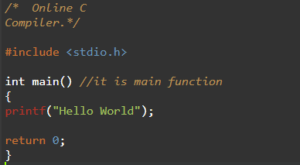
Comments can be inserted as −
- Prologue to the program to explain its objective
- At the beginning and/or end of logical or functional blocks
- Make note about special scenarios or exceptions
You should avoid adding superfluous comments as that may prove counterproductive by breaking the flow of code while reading. Compiler may ignore comments and indentations but the reader tends to read each one of them.
Indentation
Distance of text from left or right margin is called indent. In programs, indentation is used to separate logically separated blocks of code. Here’s an example of indented program segment:
As you can see, indented program is more understandable. Flow of control from for loop to if and back to for is very clear. Indentation is especially useful in case of control structures.
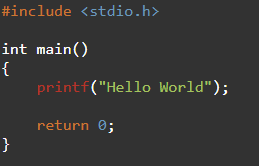
With Indentation
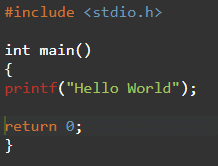
Without Indentation
Inserting blank spaces or lines is also part of indentation. Here are some situations where you can and should use indentation −
- Blank lines between logical or functional blocks of code within the program
- Blank spaces around operators
- Tabs at the beginning of new control structures
Programming Methodologies
Identifying and removing errors from a program or software is called debugging. Debugging is ideally part of testing process but in reality it is done at every step of programming. Coders should debug the smallest of their modules before moving on. This decreases the number of errors thrown up during the testing phase and reduces testing time and effort significantly. Let us look at the types of errors that can crop up in a program.
Syntax Errors
Syntax errors are the grammatical errors in a program. Every language has its own set of rules, like creating identifiers, writing expressions, etc. for writing programs. When these rules are violated, the errors are called syntax errors. Many modern integrated development environments can identify the syntax errors as you type your program. Else, it will be shown when you compile the program. Let us take an example −
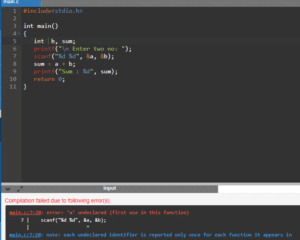
In this program, the variable a has not been declared, which is thrown up by the compiler.
Semantic Errors
Semantic errors are also called logical errors. The statement has no syntax errors, so it will compile and run correctly. However, it will not give the desired output as the logic is not correct. Let us take an example.
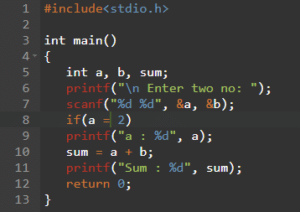
Look at line 8. Here programmer wants to check if the divisor is 0, to avoid division by 0. However, instead of using the comparing operator ==, assignment operator = has been used. Now every time the “if expression” will evaluate to true and program will give output as “You cannot divide by 0”. Definitely not what was intended!!
Logical errors cannot be detected by any program; they have to be identified by the programmer herself when the desired output is not achieved.
Runtime Errors
Runtime errors are errors that occur while executing the program. This implies that the program has no syntax errors. Some of the most common run time errors your program may encounter are −
- Infinite loop
- Division by ‘0’
- Wrong value entered by user (say, string instead of integer)
Code Optimization
Any method by which code is modified to improve its quality and efficiency is called code optimization. Code quality determines life span of code. If the code can be used and maintained for a long period of time, carried over from product to product, its quality is deemed to be high and it has a longer life. On the contrary, if a piece of code can be used and maintained only for short durations, say till a version is valid, it is deemed to be of low quality and has a short life.
Reliability and speed of a code determines code efficiency. Code efficiency is an important factor in ensuring high performance of a software.
There are two approaches to code optimization −
- Intuition based optimization (IBO)− Here the programmer tries to optimize the program based on her own skill and experience. This might work for small programs but fails miserably as complexity of the program grows.
- Evidence based optimization (EBO)− Here automated tools are used to find out performance bottlenecks and then relevant portions optimize accordingly. Every programming language has its own set of code optimization tools. For example, PMD, FindBug and Clover are used to optimize Java code.
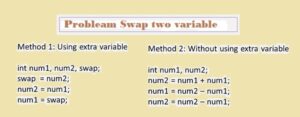
Code is optimized for execution time and memory consumption because time is scarce and memory expensive. There has to be a balance between the two. If time optimization increases load on memory or memory optimization makes the code slower, purpose of optimization will be lost.
Execution Time Optimization
Optimizing code for execution time is necessary to provide fast service to the users. Here are some tips for execution time optimization −
- Use commands that have built-in execution time optimization
- Use switch instead of if condition
- Minimize function calls within loop structures
- Optimize the data structures used in the program
Memory Optimization
As you know, data and instructions consume memory. When we say data, it also refers to interim data that is the result of expressions. We also need to keep a track of how many instructions are making up the program or the module we are trying to optimize. Here are some tips for memory optimization −
- Use commands that have built-in memory optimization
- Keep the use of variables that need to be stored in registers minimum
- Avoid declaring global variables inside loops that are executed many times
- Avoid using CPU intensive functions like sqrt()

0 Comments